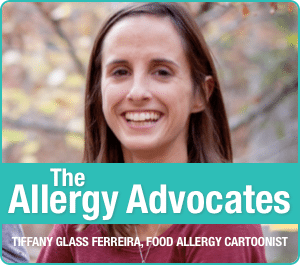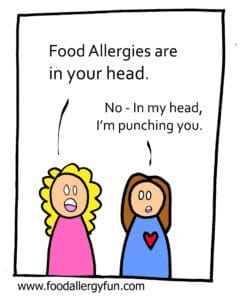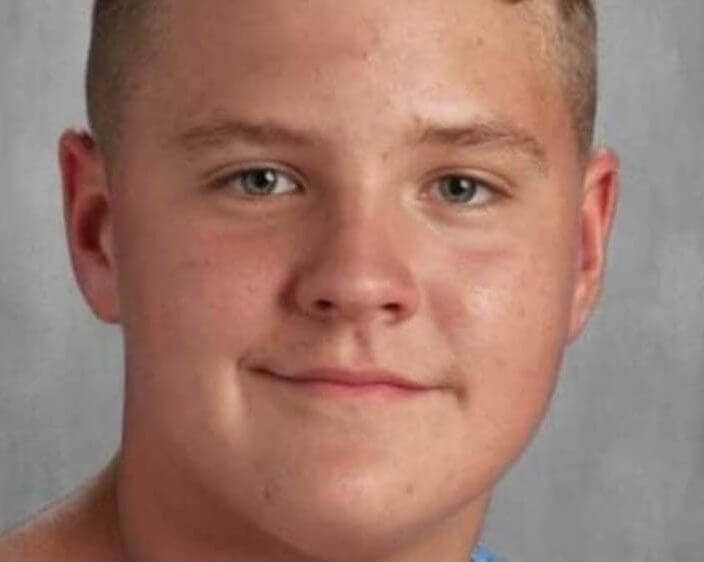 Art is a huge part of Tiffany Glass Ferreira’s life. An art teacher by training, she used to teach the subject in public schools and today gives classes at a museum, and has a small business making art on shrinkable plastic.
Art is a huge part of Tiffany Glass Ferreira’s life. An art teacher by training, she used to teach the subject in public schools and today gives classes at a museum, and has a small business making art on shrinkable plastic.
So naturally when this artist-mom hit roadblocks managing her son’s food allergies, she turned to pencil and paper (well, a napkin, at first) for catharsis.
Her cartoons about food allergies feature stick figures who pointedly depict real-life conversations. They sum up absurdity at a glance, and include retorts that allergy parents only wish they could say.
It’s no wonder that Glass Ferreira’s cartoons have caused something of an online sensation in food allergy circles – new ones are shared repeatedly across social media, and not only across the United States, but around the globe.
In the first of our Allergy Advocates series for 2015, Allergic Living is delighted to honor Tiffany Glass Ferreira for her ability to educate others about food-allergy realities. She does so with humor, creativity, wit, and unvarnished honesty.
These days, Glass Ferreira is lending her talent to a cause she strongly believes in – her latest cartoons support expanding the right to have stock epinephrine in Virginia from just schools to businesses, including restaurants. This bill is currently in front of the senate’s education and health committee.
Allergic Living contributor Claire Gagné speaks to Tiffany Glass Ferreira about the inspiration for her cartoons, and also what it’s like to be an unpopular voice in a public debate.
 When did your journey into the food-allergy world begin?
When did your journey into the food-allergy world begin?
We found out that my son was allergic to milk when he was a small baby, because he had severe eczema from milk I was passing to him while nursing.
Then on his first birthday, he ate a cupcake that had egg in it. He got hives, threw up and started swelling.
We learned from there. We’ve been through four different allergists, and up and down through false positives and false negatives on the testing.
He was cleared for nut allergy but then, at 3 ½ years old, a cashew took him down. It was an anaphylactic reaction, and he went for an ambulance ride, had the IV steroids, the whole thing. That was our big one.
He’s turning 8 next month and I have a daughter who is 5. I hesitate to say she has no allergies, because to me, those are famous last words.

Why did you start drawing cartoons about allergies?
I started about five years ago. When I was really upset, it was not necessarily that the allergies themselves were frustrating. It was what people said to me or comments I’d read on a blog post that bothered me and would keep me up at night.
I started to draw cartoons and post them online as comic relief for myself. But then I started to get comments and contacts from all over the world. I realized – not only do people in Canada, Spain, Brazil and Australia deal with food allergies – just like me – but they have relatives who say crazy things, just like me.
Do you base cartoons on your family members?
I don’t have a lot of drama in my family. But yes, sometimes the cartoons are based on what some relatives will say. But I figure, if you tell me to smell something to see if there’s nuts in it, that’s fair game to put in a cartoon.
Where else do you get inspiration from?
Frustration. For example, in my town there are all these great ice cream shops, so everyone always says, “have you been to this ice cream shop ….”
We can’t go to the ice cream shops because of my son’s milk allergy, but every time someone asks, I can’t say, “we have allergies, do you know what that means?” So I just say “no”.
But with something like that, when it starts to make me unhappy, I draw the cartoon, and then I laugh about it and it becomes funny.
But not all your cartoons are funny.
No, sometimes they are used to make a point. One cartoon I have drawn says, “We can either stock epinephrine and save the next child, or wish we had.” That is not a funny joke. But that image has been used in both Colorado and California to communicate with legislators.
Next: The events that lead to “Skittlegate”.





